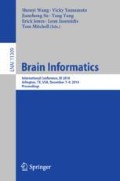Abstract
In this paper a novel methodology for assessing source connectivity applied to emotional states discrimination is proposed. The method involves (i) designing the set of Regions-of-interest (ROIs) over the cortical surface, (ii) estimating the ROI time-courses using a dynamic inverse problem formulation, (iii) estimating the pairwise functional connectivity between ROIs, and (iv) feeding a Support Vector Machine Classifier with the estimated connectivity to discriminate between emotional states. The performance of the proposed methodology is evaluated over a real database where obtained results improve state-of-the-art methods that either compute connectivity between pairs of EEG channels or do not consider the non-stationary nature of the EEG data.
Access this chapter
Tax calculation will be finalised at checkout
Purchases are for personal use only
References
Koppert, M., Kalitzin, S., Velis, D., da Silva, F.L., Viergever, M.: Dynamics of collective multi-stability in models of distributed neuronal systems. Int. J. Neural Syst. 24(2), 1430004 (2014)
Lei, X., Wu, T., Valdes-Sosa, P.A.: Incorporating priors for EEG source imaging and connectivity analysis. Front. Neurosci. 9, 284 (2015)
Schoffelen, J.M., Gross, J.: Source connectivity analysis with MEG and EEG. Hum. Brain Mapp. 30(6), 1857–1865 (2009)
Hurtado-Rincón, J.V., Martínez-Vargas, J.D., Rojas-Jaramillo, S., Giraldo, E., Castellanos-Dominguez, G.: Identification of relevant inter-channel EEG connectivity patterns: a kernel-based supervised approach. In: Ascoli, G.A., Hawrylycz, M., Ali, H., Khazanchi, D., Shi, Y. (eds.) BIH 2016. LNCS (LNAI), vol. 9919, pp. 14–23. Springer, Cham (2016). https://doi.org/10.1007/978-3-319-47103-7_2
Gupta, R., Hur, Y.J., Lavie, N.: Distracted by pleasure: effects of positive versus negative valence on emotional capture under load. Emotion 16(3), 328 (2016)
Chella, F., Pizzella, V., Zappasodi, F., Marzetti, L.: Impact of the reference choice on scalp eeg connectivity estimation. J. Neural Eng. 13(3), 036016 (2016)
Lai, M., Demuru, M., Hillebrand, A., Fraschini, M.: A comparison between scalp-and source-reconstructed EEG networks. Sci. Rep. 8(1), 12269 (2018)
Bastos, A.M., Schoffelen, J.M.: A tutorial review of functional connectivity analysis methods and their interpretational pitfalls. Front. Syst. Neurosci. 9, 175 (2016)
Baillet, S., Mosher, J.C., Leahy, R.M.: Electromagnetic brain mapping. IEEE Signal Process. Mag. 18, 14–30 (2001)
Haufe, S., et al.: Large-scale EEG/MEG source localization with spatial flexibility. NeuroImage 54(2), 851–859 (2011)
Castaño-Candamil, S., Höhne, J., Martínez-Vargas, J.D., An, X.W., Castellanos-Domínguez, G., Haufe, S.: Solving the EEG inverse problem based on space-time-frequency structured sparsity constraints. NeuroImage 118, 598–612 (2015)
Martinez-Vargas, J.D., Strobbe, G., Vonck, K., van Mierlo, P., Castellanos-Dominguez, G.: Improved localization of seizure onset zones using spatiotemporal constraints and time-varying source connectivity. Front. Neurosci. 11, 156 (2017)
Chen, X., Lin, Q., Kim, S., Carbonell, J.G., Xing, E.P.: Smoothing proximal gradient method for general structured sparse regression. Ann. Appl. Stat. 6(2), 719–752 (2012)
Gupta, R., Falk, T.H., et al.: Relevance vector classifier decision fusion and EEG graph-theoretic features for automatic affective state characterization. Neurocomputing 174, 875–884 (2016)
Srinivasan, R., Winter, W.R., Ding, J., Nunez, P.L.: EEG and MEG coherence: measures of functional connectivity at distinct spatial scales of neocortical dynamics. J. Neurosci. Methods 166(1), 41–52 (2007)
Koelstra, S., et al.: Deap: a database for emotion analysis; using physiological signals. IEEE Trans. Affect. Comput. 3(1), 18–31 (2012)
Haufe, S., Ewald, A.: A simulation framework for benchmarking EEG-based brain connectivity estimation methodologies. Brain Topogr., 1–18 (2016). https://doi.org/10.1007/s10548-016-0498-y, ISSN 1573-6792
Huang, Y., Parra, L.C., et al.: The new york head- a precise standardized volume conductor model for EEG source localization and TES targeting. NeuroImage 140, 150–162 (2016)
Friston, K., et al.: Multiple sparse priors for the M/EEG inverse problem. NeuroImage 39(3), 1104–1120 (2008)
Padilla-Buritica, J.I., Martinez-Vargas, J.D., Castellanos-Dominguez, G.: Emotion discrimination using spatially compact regions of interest extracted from imaging EEG activity. Front. Comput. Neurosci. 10, 55 (2016)
Hata, M., et al.: Functional connectivity assessed by resting state eeg correlates with cognitive decline of alzheimer’s disease-an eloreta study. Clin. Neurophysiol. 127(2), 1269–1278 (2016)
Acknowledgments
This work was carried out under the funding of COLCIENCIAS. Research project: 111077757982: “Sistema de identificación de fuentes epileptogénicas basado en medidas de conectividad funcional usando registros electroencefalográficos e imágenes de resonancia magnética en pacientes con epilepsia refractaria: apoyo a la cirugía resectiva”.
Author information
Authors and Affiliations
Corresponding author
Editor information
Editors and Affiliations
Rights and permissions
Copyright information
© 2018 Springer Nature Switzerland AG
About this paper
Cite this paper
Martinez-Vargas, J.D., Nieto-Mora, D.A., Muñoz-Gutiérrez, P.A., Cespedes-Villar, Y.R., Giraldo, E., Castellanos-Dominguez, G. (2018). Assessment of Source Connectivity for Emotional States Discrimination. In: Wang, S., et al. Brain Informatics. BI 2018. Lecture Notes in Computer Science(), vol 11309. Springer, Cham. https://doi.org/10.1007/978-3-030-05587-5_7
Download citation
DOI: https://doi.org/10.1007/978-3-030-05587-5_7
Published:
Publisher Name: Springer, Cham
Print ISBN: 978-3-030-05586-8
Online ISBN: 978-3-030-05587-5
eBook Packages: Computer ScienceComputer Science (R0)

